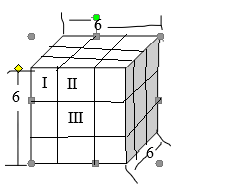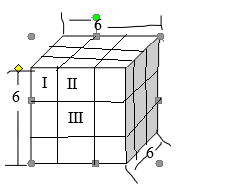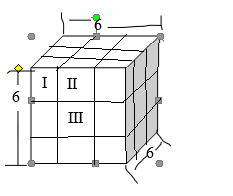
Concept explainers
a.
To calculate: The number of small cubes having six faces painted.
a.
Answer to Problem 11PSC
There are no small cubes having six faces painted.
Explanation of Solution
Given information:
A six inch cube is painted on the outside and cut into 27 smaller cubes.
Calculation:

The number of small cubes having various faces painted are as follows:
6 faces painted = 0,
5 faces painted = 0,
4 faces painted = 0,
3 faces painted = 8
2 faces painted = 10,
1 faces painted = 6,
No faces painted = 1.
8 cubes like ⏸.
12 cubes like ⏸.
6 cubes like ⏸.
1 in center.
b.
To find: The probability that it has at least two painted faces if one of the small cubes is selected at random.
b.
Answer to Problem 11PSC
The probability is
Explanation of Solution
Given information:
A six inch cube is painted on the outside and cut into 27 smaller cubes.
Formula used:
Probability of event to happen is
Calculation:

The number of small cubes having various faces painted are as follows:
6 faces painted = 0,
5 faces painted = 0,
4 faces painted = 0,
3 faces painted = 8
2 faces painted = 10,
1 faces painted = 6,
No faces painted= 1.
8 cubes like ⏸.
12 cubes like ⏸.
6 cubes like ⏸.
1 in center.
Probability means possibility.
The probability formula is defined as the possibility of an event to happen is equal to the ratio of the number of favorable outcomes and the total number of outcomes.
Probability of event to happen is
A six inch cube is painted on the outside and cut into 27 smaller cubes.
Thera are 27 total number of outcomes.
The number of favorable outcomes
P(two painted faces if one of the small cubes is selected at random)
c.
To calculate: The total area of the unpainted surfaces.
c.
Answer to Problem 11PSC
The total area of the unpainted surfaces is
Explanation of Solution
Given information:
A six inch cube is painted on the outside and cut into 27 smaller cubes.
Formula used:
Total area = Area of each cube
Calculation:

Each cube is 2 by 2, so the area of each cube = 4.
| Type of cube | Number of unpainted faces | Number of cubes | Number of unpainted faces |
| ⏸ | 3 | 8 | 24 |
| ⏸ | 4 | 12 | 48 |
| ⏸ | 5 | 6 | 30 |
| In center | 6 | 1 | 6 |
Total number of unpainted faces
Total area = Area of each cube
Total area
Chapter 12 Solutions
Geometry For Enjoyment And Challenge
Additional Math Textbook Solutions
College Algebra (7th Edition)
Thinking Mathematically (6th Edition)
Pre-Algebra Student Edition
Calculus for Business, Economics, Life Sciences, and Social Sciences (14th Edition)
A First Course in Probability (10th Edition)
University Calculus: Early Transcendentals (4th Edition)
- Name: Tan Tong 16.5 Bonvicino - Period 5 1 Find the exact volume of a right hexagonal prism such that the base is a regular hexagon with a side length of 8 cm and whose distance between the two bases is 5 cm. Show all work. (4 pts) 83 tan 30°= Regular hexagon So length ~ 480 tango Cm Hexagon int angle =36016 8cm Angle bisec isper p bisect Side length 4 X=an 300 2 In the accompanying diagram of circle O, PA is tangent to the circle at A, PDC is a secant, diameter AEOC intersects chord BD at E, chords AB, BC, and DA are drawn, mDA = 46° and mBC is 32° more than mAB. If the radius of the circle is 8 cm, E is the midpoint of AO and the length of ED is 2 less than the length of BE, answer each of the following. Show all work. (a) marrow_forward18:36 G.C.A.2.ChordsSecantsandTa... จ 76 完成 2 In the accompanying diagram, AABC is inscribed in circle O, AP bisects BAC, PBD is tangent to circle O at B, and mZACB:m/CAB:m/ABC= 4:3:2 D B P F Find: mZABC, mBF, m/BEP, m/P, m/PBC ← 1 Őarrow_forward14:09 2/16 jmap.org 5G 66 In the accompanying diagram of circle O, diameters BD and AE, secants PAB and PDC, and chords BC and AD are drawn; mAD = 40; and mDC = 80. B E Find: mAB, m/BCD, m/BOE, m/P, m/PAD ← G.C.A.2.ChordsSecantsand Tangent s19.pdf (538 KB) + 4 保存... Xarrow_forward16:39 < 文字 15:28 |美图秀秀 保存 59% 5G 46 照片 完成 Bonvicino - Period Name: 6. A right regular hexagonal pyramid with the top removed (as shown in Diagram 1) in such a manner that the top base is parallel to the base of the pyramid resulting in what is shown in Diagram 2. A wedge (from the center) is then removed from this solid as shown in Diagram 3. 30 Diogram 1 Diegrom 2. Diagram 3. If the height of the solid in Diagrams 2 and 3 is the height of the original pyramid, the radius of the base of the pyramid is 10 cm and each lateral edge of the solid in Diagram 3 is 12 cm, find the exact volume of the solid in Diagram 3, measured in cubic meters. Show all work. (T 文字 贴纸 消除笔 涂鸦笔 边框 马赛克 去美容arrow_forwardAnswer question 4 pleasearrow_forward16:39 < 文字 15:28 |美图秀秀 保存 59% 5G 46 照片 完成 Bonvicino - Period Name: 6. A right regular hexagonal pyramid with the top removed (as shown in Diagram 1) in such a manner that the top base is parallel to the base of the pyramid resulting in what is shown in Diagram 2. A wedge (from the center) is then removed from this solid as shown in Diagram 3. 30 Diogram 1 Diegrom 2. Diagram 3. If the height of the solid in Diagrams 2 and 3 is the height of the original pyramid, the radius of the base of the pyramid is 10 cm and each lateral edge of the solid in Diagram 3 is 12 cm, find the exact volume of the solid in Diagram 3, measured in cubic meters. Show all work. (T 文字 贴纸 消除笔 涂鸦笔 边框 马赛克 去美容arrow_forwardTo approximate the length of a marsh, a surveyor walks x = 400 meters from point A to point B. Then, the surveyor turns 75° and walks 220 meters to point C (see figure). Approximate the length AC of the marsh. (Round your answer to one decimal place.) m C B 75° 220 m x marrow_forward. The students who attend Memorial High School have a wide variety of extra-curricular activities to choose from in the after-school program. Students are 38% likely to join the dance team; 18% likely to participate in the school play; 42% likely to join the yearbook club; and 64% likely to join the marching band. Many students choose to participate in multiple activities. Students have equal probabilities of being freshmen, sophomores, juniors, or seniors.What is the probability of the union of being either a freshman or senior? 0.07 0.44 0.50 0.25arrow_forwardWhich angles are complementary to each other? Select all that apply. 3 2 4 in 5 1 Z1 and 23 Z1 and 25 22 and 23 Z2 and 25 Submitarrow_forwardarrow_back_iosSEE MORE QUESTIONSarrow_forward_ios
 Elementary Geometry For College Students, 7eGeometryISBN:9781337614085Author:Alexander, Daniel C.; Koeberlein, Geralyn M.Publisher:Cengage,
Elementary Geometry For College Students, 7eGeometryISBN:9781337614085Author:Alexander, Daniel C.; Koeberlein, Geralyn M.Publisher:Cengage, Elementary Geometry for College StudentsGeometryISBN:9781285195698Author:Daniel C. Alexander, Geralyn M. KoeberleinPublisher:Cengage Learning
Elementary Geometry for College StudentsGeometryISBN:9781285195698Author:Daniel C. Alexander, Geralyn M. KoeberleinPublisher:Cengage Learning

